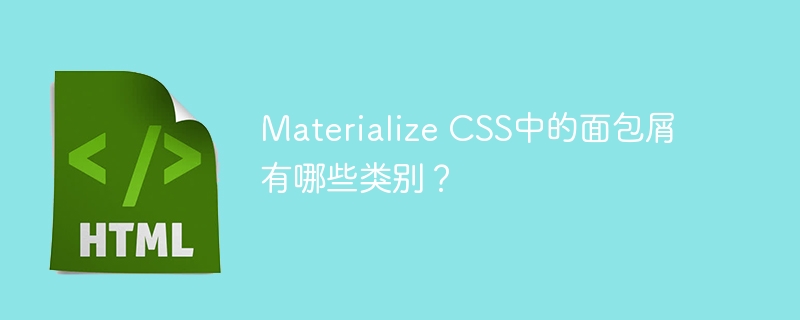

Materialize is a CSS framework for design that uses classic principles and combines them with innovation and technology. The creators of Materialize are Google, who developed a design system that provides every user with a unified user experience in any type of product, regardless of the platform they are using. Breadcrumbs is a component built into Materialize CSS that is primarily used to display the user's current location when there are many levels, whether on a website or a web application.
In this article we are going to have a look at the classes of breadcrumb in materialize CSS?
CSS classes present in Materialize CSS are used to easily create breadcrumbs. Classes used include -
Breadcrumb class − The breadcrumb class is used to show that the last anchor tag is active, and the rest are grayed out.
nav-wrapper class − This class is used to set the component of the nav to breadcrumb.
Let’s take a look at the syntax for creating breadcrumbs in Materialize CSS
<nav>
<div class="nav-wrapper blue">
<a href="#html5" class="breadcrumb">HTML</a>
<a href="#materialize example" class="breadcrumb">Materialize example</a>
<a href="#breadcrumb" class="breadcrumb example">BreadCrumb example</a>
</div>
</nav>
In the above example you can see that we first opened a nav tag and then created a class nav-wrapper after which we created 3 different anchor tags and gave them the breadcrumb class.
To better understand the concept of breadcrumb navigation, let’s look at an example
The Chinese translation ofIn the example, the approach we will take is to create a simple breadcrumb, meaning the HTML will point to the breadcrumb page. Let’s take a look at the code
<!DOCTYPE html>
<html lang="en">
<head>
<title>Example of breadcrumb CSS</title>
<style>
.breadcrumb {
padding: 0.5rem 1rem;
background-color: #f5f5f5;
color: #333;
font-size: 1rem;
text-decoration: none;
font-family: Arial, sans-serif;
}
.breadcrumb:hover {
background-color: #2596be;
}
.breadcrumb:active {
background-color:#efaf67;
}
.breadcrumb:not(:last-child):after {
content: ">";
padding: 0 0.5rem;
}
</style>
</head>
<body>
<nav>
<div class="nav-wrapper">
<div class="col s12">
<a href="#!" class="breadcrumb">First</a>
<a href="#!" class="breadcrumb">Second</a>
<a href="#!" class="breadcrumb">Third</a>
</div>
</div>
</nav>
</body>
</html>
In the above example, we have used the "breadcrumb" class, which helps us anchor the elements located within the "nav" element. The user can use different classes like "cyan" or "light-blue" to change the color of the breadcrumbs, or if the user wants to change the position of the breadcrumbs to the right, they can use the "right" class.
Note − There are different ways to install materialize CSS. One way is to go to the official website of the materialize CSS and then download the latest version available in which you would have to download the materialize. min.js and materialize.min.css in the directory where your project is stored.
The second way to install or use the materialize CSS is by using the CDN versions and then including these CDN links inside the script tag and after which you can use all of the features of the materialize CSS.
Let’s look at another example to understand the categories of breadcrumbs in Materialize CSS
The Chinese translation ofIn this example we will be creating a simple breadcrumb by using the current location of the breadcrumb that is active.
The code for making breadcrumbs is as follows:
<!DOCTYPE html>
<html lang="en">
<head>
<title>Example</title>
<style>
.breadcrumb {
background-color: rgb(255, 99, 71); /* tomato */
background-color: hsl(9, 100%, 64%); /* tomato */
background-color: #ff6347; /* tomato */
background-color: rgba(255, 99, 71, 0.5); /* tomato with 50% transparency */
font-family: Arial, sans-serif;
padding: 0 50px ;
}
</style>
</head>
<body>
<nav class="red">
<div class="nav-wrapper">
<div class="col s12">
<a href="#!" class="breadcrumb">First</a>
<a href="#!" class="breadcrumb">Second</a>
<a href="#!" class="breadcrumb">Third</a>
</div>
</div>
</nav>
</body>
</html>
In the above code, we first added the materialize CSS CDN and some external fonts, then started our HTML code, used the breadcrumb class in it, and added three links, and then changed the nav-wrapper.
Materialize CSS is a front-end framework which is based on material design and is responsive as the developer can use custom components and animations and transitions and then focuses on the user experience as the framework provides the user a responsive system across all the platforms which are available to the user.
There are various themes that can be used to implement CSS, and there are detailed examples to make it easy to use.
Materialize CSS is a language that combines design with innovation and technology, designed by Google to provide a refined user experience for all platforms. Breadcrumbs are a component built into Materialize CSS. When there is a large amount of content, various classes can be used to easily create breadcrumbs.
In this article we saw what are the classes of the breadcrumb in the materialize CSS and what is materialize CSS.
The above is the detailed content of What categories are there for breadcrumbs in Materialize CSS?. For more information, please follow other related articles on the PHP Chinese website!




